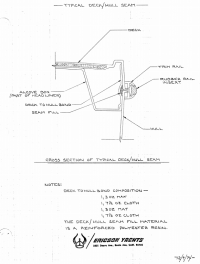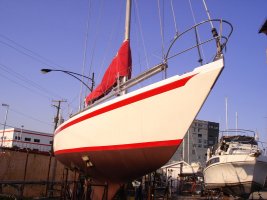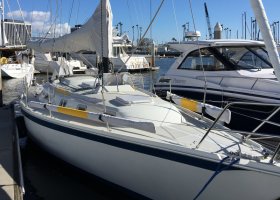Glenn McCarthy
Glenn McCarthy
Sooooo, we got a new larger mainsail, got rid of the undersized original rudder, installed a new Foss rudder, tuned the mast to vertical, went out in a good breeze in two 30 mile races - and she sails like a sailboat. The oscillations are gone. We also happened to win both races - quite a different experience from last year.
Thank you all for your input.
Now for the new problem, I spent 60 days in the past year getting this boat ready for the 2018 Chicago Mackinac - the whole purpose of getting this boat. All of the work we did worked flawlessly and none of it broke, there is nothing that needs repair. But then again, we only went 4-1/2 hours up the course before returning to harbor. 17-26 knots of wind, 6'-8' seas with some 10'. Nobody volunteered to bucket the boat for the predicted winds of the next 24 hours. We had our #3 and double reefed main, still a bit overpowered with the rail solidly in the water. The boat was taking on water. Not just a little, a lot. We bucketed probably 300-400 gallons and still had water over our ankles. It just kept coming in. We straightened up, pumped the boat dry, she stayed dry. I am 100% sure that the rubrail screws leak. Or let me say it a different way, with the boat some 40 years old, I am sure the rubrail has been pulled out by pilings a few times through the years, they pulled the rubber out of the aluminum extrusion, pulled the screws out that were pulled out of the fiberglass, moved them over an inch or two to solid glass, drilled new holes screwed them in, pushed the rubber rail back on and called it a day. And did not fill the old holes. I haven't had the time to check, but it is the only thing that makes sense.
The plan this weekend is to remove the rubrail for good (hey, the new rudder actually steers the boat in and out of the slip now, the rubrails aren't needed anymore. It doesn't look like Mr. Magoo steering the boat anymore), epoxy all of the holes, sand her smooth and put on a coat of paint. Never ever deal with leaks from the rubrail ever again.
Question - these screws in the rubrails don't hold the deck to the hull as a hull/deck joint do they?
Thank you all for your input.
Now for the new problem, I spent 60 days in the past year getting this boat ready for the 2018 Chicago Mackinac - the whole purpose of getting this boat. All of the work we did worked flawlessly and none of it broke, there is nothing that needs repair. But then again, we only went 4-1/2 hours up the course before returning to harbor. 17-26 knots of wind, 6'-8' seas with some 10'. Nobody volunteered to bucket the boat for the predicted winds of the next 24 hours. We had our #3 and double reefed main, still a bit overpowered with the rail solidly in the water. The boat was taking on water. Not just a little, a lot. We bucketed probably 300-400 gallons and still had water over our ankles. It just kept coming in. We straightened up, pumped the boat dry, she stayed dry. I am 100% sure that the rubrail screws leak. Or let me say it a different way, with the boat some 40 years old, I am sure the rubrail has been pulled out by pilings a few times through the years, they pulled the rubber out of the aluminum extrusion, pulled the screws out that were pulled out of the fiberglass, moved them over an inch or two to solid glass, drilled new holes screwed them in, pushed the rubber rail back on and called it a day. And did not fill the old holes. I haven't had the time to check, but it is the only thing that makes sense.
The plan this weekend is to remove the rubrail for good (hey, the new rudder actually steers the boat in and out of the slip now, the rubrails aren't needed anymore. It doesn't look like Mr. Magoo steering the boat anymore), epoxy all of the holes, sand her smooth and put on a coat of paint. Never ever deal with leaks from the rubrail ever again.
Question - these screws in the rubrails don't hold the deck to the hull as a hull/deck joint do they?
Last edited:



